Journalism Resume: Template & Writing Guide for 2024
A journalist is tasked with sharing news and current events with people through the media. This is a competitive industry so you can expect a hiring manager to look closely at your journalism resume. When applying for this position, you need to show you can handle tight deadlines and have specific skills.
When a job description goes up in journalism, thousands of people are going to be interested. You need to prove you’re the person that recruiters should be looking at. Since journalism is a job so many people want, you need an impressive newspaper reporter resume.
It might seem overwhelming to think about competing with so many other people. However, creating a fine-tuned journalism resume may not be as challenging as you assume. When you have tips to create an excellent resume, the process can be straightforward and simple.
There’s no better way to speed up the process than a resume builder. You can get a custom resume that shows your skills in a matter of minutes. But, even with help, you need to make sure you get everything right. Keep reading to find out everything you need to know to do that.
Journalism Resume Examples
Looking at a selection of journalist resume samples is a great first step to making your own professional document. As you view different samples, you can get an idea of what works best. You may also see things you want to stay away from as your craft your own resume.
Journalist resume examples can be found across the Internet. You’ll find versions for every kind of journalism job you can imagine. One of the things you’ll quickly notice is that most of them hold the same type of information. Adding those things to your own resume will make sure it stands up to the resumes of competitors in the journalism world.
As you work through our guide, you’ll see several sample journalism resumes. Both full resumes and resume sections are provided to ensure you have all the information you need. Use these to get a visual representation of the resume you want to create. While you can be creative, especially as a journalist, the basic needs to be included.
Right below, you can see our sample resume for a journalist. Use it throughout this guide to build the best resume you can.
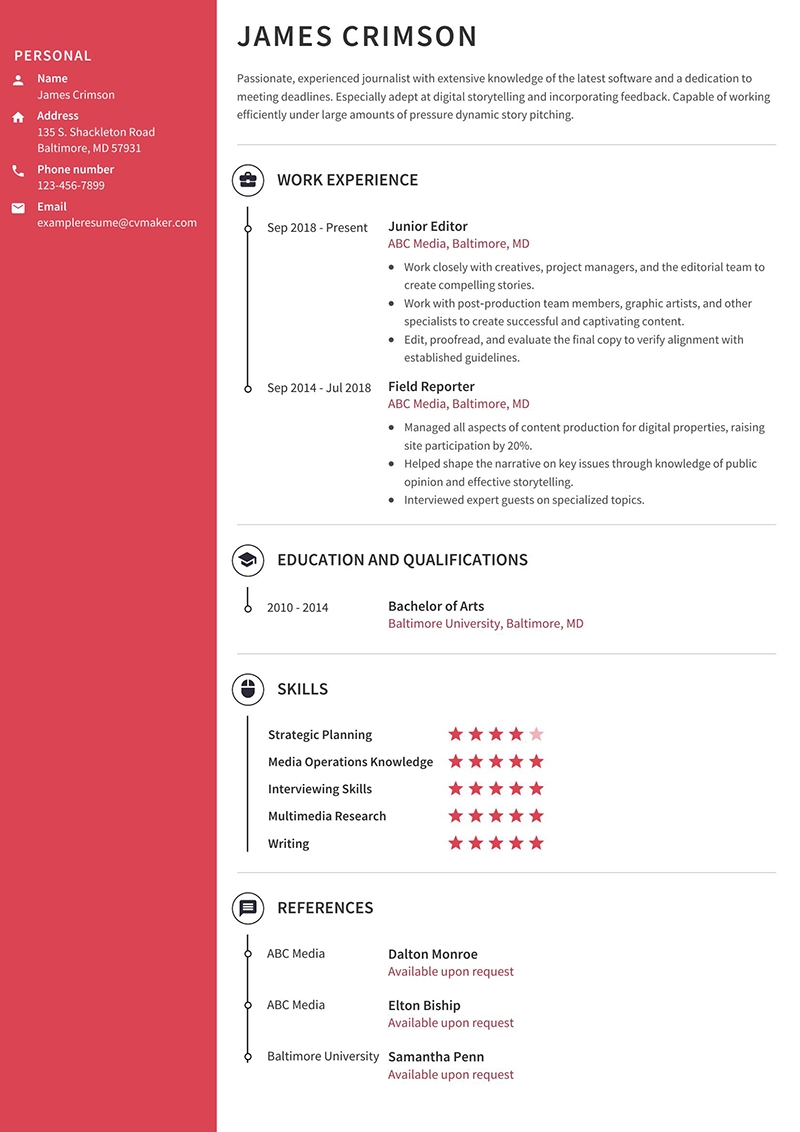
How to Write a Journalist Resume in 2024: Full Guide to Successful Journalism Resumes
When you look at various news reporter resume, you might wonder where to start. There are several things to be aware of as you start gathering and putting down your information. The first is that a clean resume template is a good choice. This is easier for a recruiter to read, which makes it more likely they will contact you.
You also want to be sure that you get all the information on your business journalism resume right. Making some kind of error and not fixing it isn’t going to do the best job of showing off your writing and editing chops for a journalism position. Use Grammarly or a similar program at the end to proofread and make sure everything is perfect.
Most people writing a court reporter resume will want to choose the reverse-chronological format. This puts your most recent experience first and shows the things you are capable of right now. It’s also highly useful for applicant tracking systems (ATS) that scan your resume before a hiring manager ever sees it.
If you’re making a journalism student resume, you can choose a different format. A functional resume focuses more on skills and education than experience. This ensures you put your best abilities forward and are more likely to get an interview for that journalism position you would love to have.
While writing the resume, make sure to use a modern but legible font. Leaving in some white space is a good idea to make the text stand out and be easier to read. When choosing fonts, use no more than two or three. Going beyond that may make things harder to understand.
A final tip is to keep the job description handy. As you’ll soon find out, it will be useful as you create the resume. Once you get through the guide and have the document ready, make sure to save it in a PDF format. This ensures that nothing alters the format and it looks great on the screen or printed out and in someone’s hand.
Now that you know the basics, we want to look at each section of the resume. This includes your contact information, resume objective, work experience, education, skills, and references. We’ll share images for each section and offer helpful tips that help you create a resume you’re proud of.
Section #1: Contact Information
The first section you want to write for a resume for a journalist is the contact information. This is the area where you introduce yourself to the person who might be reading. Rather than getting into why you’re good for the job, use this for the basic information you want to convey about yourself.
This area is the first place the eye will go when reading your resume. It might be skimmed before the rest of the resume is read. However, if a manager feels you would be a good fit, they’ll come back to this so they can get into contact with you. That makes it essential to get all of the information right.
Contact Information Example
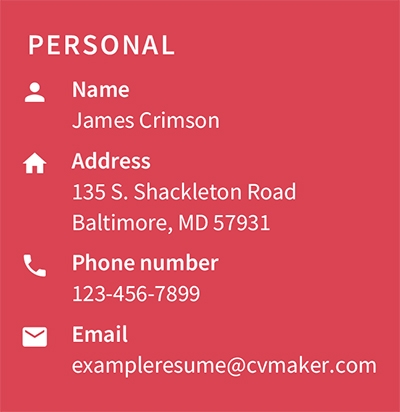
Regardless of industry, you want a contact info section like the one above. You can see quickly what is important to share. For instance, this image has the applicant’s name and address. Underneath, you see two ways to get in contact with them. These are needed on any resume so make sure you include them with your own.
You might wonder if you should add other info, such as your social media accounts. This isn’t a bad idea in some cases, especially if you have professional accounts on sites like LinkedIn. However, it’s not required so it’s ultimately up to you.
How to Format This Section
Formatting the contact information is simple. Use an easy-to-read font rather than something fancier. Think about professionalism as you choose. Otherwise, the most important thing is getting the right things on the page. Add your full name on the top in a bold font. Underneath, add your location. Then choose two forms of contact and add those.
This is your calling card on a journalism resume so it needs to be done right. Check for typos and errors before you ever think about sending the document to others.
Section #2: Resume Objective
A professional resume should include a resume summary, also called a resume objective. If the contact information is the basics, this is where you add detail. That doesn’t mean going into more depth about contacting you but ensuring a manager knows you’d be great for a job.
Wondering how to do that? You write a short elevator pitch that puts all your accomplishments front and center. Choose wisely and add only the things that relate to the job and how great you would be if you were doing it.
Resume Objective for an Entry Level Journalism Resume

Our first example doesn’t rely on your years of experience. It’s more suited for an entry-level journalist. As you can see, it has insight into the skills the person has rather than what they’ve done in a professional environment. Consider what you’ve done that fits the job and include that in your short pitch.
Resume Objective for an Experienced Journalist Resume

For those who are a bit more experienced, make sure you list relevant skills (especially those you see in the job description). Use action verbs to make your skills and accomplishments stand out. Brainstorm your achievements and then cut that down to the most crucial ones. Those can be used to build a resume objective.
How to Format This Section
The resume format for a journalist objective is simple. Use a legible font. There are no special extras to use here. The main point is to get the information across. This is typically done through a short paragraph section. You don’t want to use more than four sentences as hiring managers may find it hard to read it all.
Section #3: Professional Work Experience
The experience section is the meat of a journalism resume. This is where most managers will spend the most time reading. Most people will include past employment options here, but keep in mind that this can include things like volunteering or internships.
You don’t necessarily need to include every job you’ve had if there are several entries. Choose the ones similar to the position you want. Just keep in mind that you may need to explain sections of time not included on the resume. Otherwise, be descriptive and provide accurate information.
Professional Work Experience Example
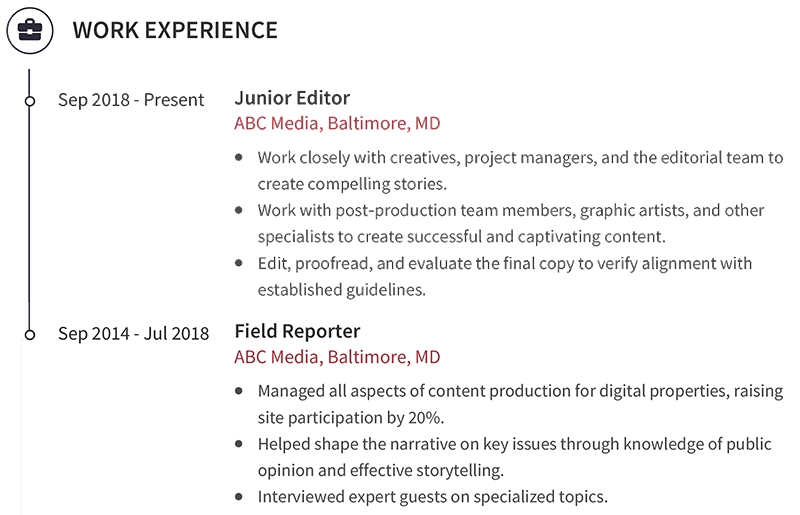
Work history matters whether you’re going for a multimedia journalist job or something else. The example above will give you more information about how this section might look visually when you are done. You’ll see it’s easy to understand where the applicant has worked, when they worked there, and what they did.
The image above conveys experience so it’s easy to understand. Make sure your own journalist resume does the same thing but with the work you have done in the past. Those with less experience will want to include other information to make the resume long enough.
How to Format This Section
Formatting comes into play in a big way with work experience. You want things to look a very specific way to get your foot in the door. First, you want a header at the top of each of your past job entries. This is where you will put in the company name, your job title, and when you worked there.
After that, your focus will be on bullet points. Use these to add additional information about what you did on the job. Include achievements whenever possible to show what you can do when on a job. A few bullet points under each job are recommended. In most cases, three to five of these will be plenty.
Section #4: Education
After working through your work experience, it’s time to build the education section. This is where you can display information about your Bachelor of Arts or whatever other degrees you might have. For those with a high school diploma only, include that. If you have degrees, there’s no need to share where you graduated high school.
When you have several degrees, the process is a bit different. It’s important to include all of these on your journalist resume. So, if you had a master’s degree, you’d include that. You’d also add on your bachelor’s degree or any certifications you have that pertain to the job.
Education Example

The image above is a great example of an education section. You quickly see that this person has a degree, where it came from, and when the degree was obtained. In most cases, that’s all you need to incorporate into the section. Certifications can be listed by date and included with the degrees. However, if you have several, you can also choose to have a section related to them.
As you create this section, use the image above to guide you. While you can make changes to it, there isn’t much that needs creativity or extra thought. Simply make sure you share the education you have with whoever is reading the professional document.
How to Format This Section
To format the education section of a perfect resume, you’ll want to do things similar to the work experience section. List the details of the school, degree, and when you got it on the top heading. Most of the time, this is all you need. However, those who have little to no experience may want to make the most of this part of the resume.
For example, you can add additional information to fill the page and provide useful tidbits to whoever is reading it. A good GPA could be included. You might choose to add in some extracurriculars or special courses you took that pertain to journalism. There’s nothing wrong with this if you want to show you went above and beyond.
Section #5: Skills
Finally, we reach skills for a journalism resume. While you might have mentioned some of these in other sections, here is where they truly shine. Journalism resume skills give more insight into what you can do and how well you can do it.
As you craft your journalist skills resume, keep the job description handy. Adding skills you find there will help prove you could be a good addition to the team. Use it to narrow down the skills that are most important to include. It’s better to have a handful of skills on the page than dozens of them.
Skills Example
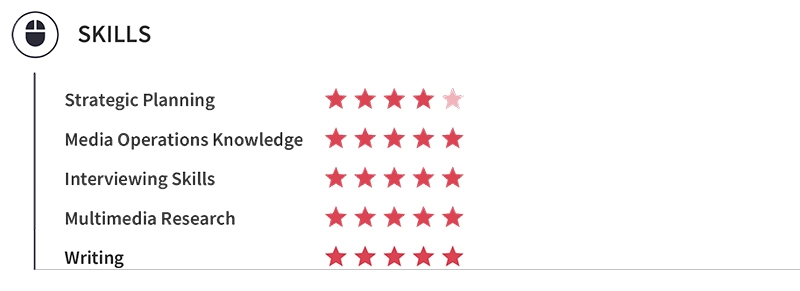
The example above gives you an idea of what the skills section might look for. However, your own skills might vary. As you consider your options, think about both soft skills and hard skills. These will be different for everyone depending on your level of experience and the things you have done in the past.
A few of the most common skills to include are communication skills, copy edit abilities, story ideas, news stories, and time management. Other options might include creating compelling coverage, doing newscasts, or fact-checking. Technology can also be good to include so consider things like knowledge of Microsoft Excel or Adobe Photoshop to round things out.
How to Format This Section
A little more creativity can be used in the skills section than others. You might have noticed that in the image above. You can do something similar or try something new. However, the basic format is to include five to 10 skills in a list. This makes it easier to take in the information than a block of text.
Beyond sharing the skills you have, make sure you indicate how adept you are at each of them. This can be done with star rankings, a simple number or word, or whatever other method works for your needs. Use colors to make things stand out if you like since it’s important for hiring managers to see what you can do.
Section #6: References
You know all about breaking news, but who is going to vouch for that? Your references are. That’s precisely what they are there for. While some people create a second page for references, that isn’t needed. Especially when you know the right format to ensure this section doesn’t take up a ton of room.
As you consider your reference options, think about who you have impressed. Are there people who will talk about how great you are at journalism who appreciate your personality and character? Those are great options for your references list. Take time to consider who you add since references are a pretty big deal.
References Example
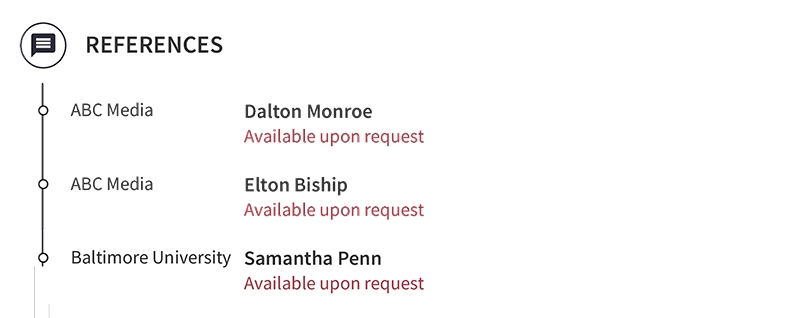
When it comes to mass communications positions, you need to show that you can collaborate and get along with others. Your references show that you’re a real team player. If you aren’t sure how to set up the references section, just take a quick look at the image above. This is a tried and true method of showing you have people in your corner.
You’ll notice that the references list the names and companies but not the contact information. This prevents random people from pulling that information. It protects the privacy of those who have agreed to be your references. There are other ways to set this up – but this one is what we recommend to be professional.
How to Format This Section
Resume writing can be a big challenge but the references section is simple like the contact information section we discussed earlier. The main point is to make this a legible section that shows other people back up your abilities and experiences. A name and a company are all you need to list.
Use a simple font and don’t go creative here. Just provide the information. You can add “available upon request” to the area where you would list the email address and phone number. If a hiring manager is interested in you, they’ll contact you to get the rest of the information.
Related Resume Templates
The journalism resume template associated with the samples throughout this page is a great option for many. However, you do have other choices, depending on the format and design you want for your journalism resume. Choosing a template is essential if you want to make the resume-writing process quick and easy.
Below you may find the journalist resume template you’ve been looking for. Keep in mind that these may not be made specifically for journalists but it only takes a few minutes to edit them. Take a look at the various options available to you and read the articles to get additional tips.
Once you have the right template, simply change the information over to reflect your experience and abilities. Tweak the font or colors and you have a beautiful resume you can use to apply to the job you want. That’s all there is to it!
Final Points on Successful Journalism Resume
At this point, you have all the information you need to build a journalism resume that anyone would be proud of. There are only a few steps left before you apply for your dream job. The most important is to create a cover letter that goes with your resume when you submit your job application.
Don’t be shy about checking up on your application once you send it in. You can also look at other jobs you might enjoy. A few tweaks to personalize the resume you just made will make it suitable for other positions. Good luck out there!